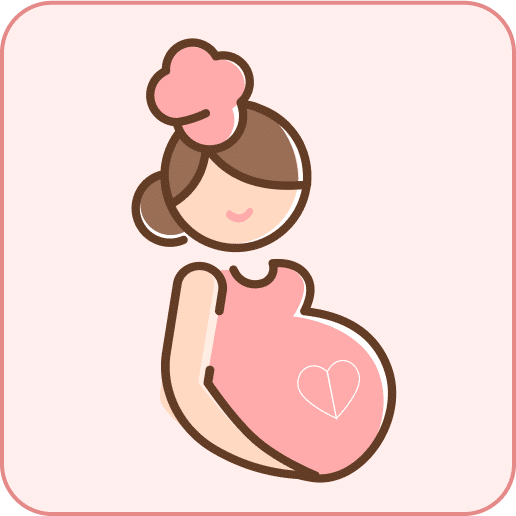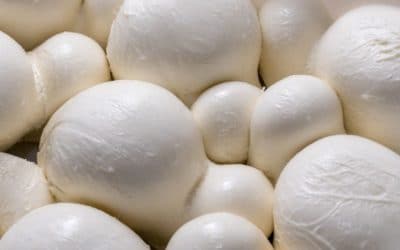Stracciatella cheese is one of the most famous Italian soft cheeses. Its name literally translates to “rag” or “little shred” because it’s made up of tiny stretched-out cheese curds. While the name doesn’t sound very appealing, the creamy taste and texture still make everyone go for seconds. This only begs the question, is it safe to enjoy when pregnant?
What is stracciatella cheese and where do you find it?
Isn’t stracciatella a gelato flavor?
Everyone’s favorite gelato flavor might be stracciatella, but the Italians didn’t stop making creamy deliciousness there. Stracciatella cheese is what you find inside of the popular pizza and salad topper; burrata. It’s made up of freshly shredded mozzarella and has a velvety soft and rich texture. The pulled mozzarella is then mixed with heavy cream to make burrata cheese, making it even more satisfying.
Where did it originate?
While the stracciatella cheese recipe originated with buffalo milk in Southern Italy, you can find this nourishingly rich cheese almost anywhere these days, made from either cow or buffalo milk. It can be eaten on its own or creatively added to a variety of dishes. Stracciatella cheese famously pairs wonderfully with pizzas, pastas, salads, and freshly sliced tomatoes drizzled with olive oil. Most Italian restaurants will offer burrata cheese somewhere on their menu, making it an easy and delicious choice whenever eating out.
Is stracciatella cheese safe to eat during pregnancy?

The importance of pasteurized milk
Stracciatella cheese is safe to eat when pregnant so long as it’s made from pasteurized milk. Lucky for your taste buds, it’s not common to find unpasteurized milk-made products like stracciatella in North America or most countries around the world. Raw milk is no longer widely used, and the USA in particular regulates cheese to ensure its safety with the FDA. Feel free to ask the waiter to confirm, but in general, there’s not much need to worry about eating pizza while on vacation in Italy (where burrata cheese reigns) or with your arugula appetizer.
What happens if I eat unpasteurized milk products?
Raw unpasteurized milk can cause food poisoning, so it’s important to watch for any symptoms if you’re in doubt, such as vomiting, diarrhea, abdominal pain, or any flu-like symptoms. Pregnant women are more susceptible to listeria, found in raw milk products, and it can harm the baby even if you aren’t feeling ill. If you notice any symptoms, call your doctor immediately.
Buying stracciatella cheese safely at the deli
If you’re buying it to take home you can check the package label for the ‘best before’ date or ask the deli shopkeeper directly when it expires. Be sure to check it’s properly packaged and protected to prevent cross-contamination. Keep in mind, it’s best to eat soft cheese within 24 hours of purchase to avoid risk from harmful bacteria or listeria. While it may be tasty, it doesn’t have the longest shelf life. Luckily, its deliciousness makes it unlikely you’d wait very long to eat it anyway. As with all foods, especially soft cheeses, be sure not to consume any ingredients after the ‘best before’ date. Store it safely in the fridge and you can even heat the cheese thoroughly, until it steams, to ensure its safety.
Ordering a plate containing stracciatella cheese at the restaurant
Ask the waiter to confirm it’s freshly made, safe to eat, and pasteurized before ordering. Remember, many restaurants will likely have burrata instead of stracciatella cheese on the menu, so be sure to ask about the safety of either one. If the restaurant is in doubt, it’s best to order another dish without soft cheese.

Are there any benefits to Stracciatella cheese during pregnancy?
A power source of vitamin B12
As with most cheeses, stracciatella is nutrient-dense with a variety of vitamins and minerals. What’s special about stracciatella is the amount of Vitamin B12. This essential vitamin helps with a variety of functions, such as the production of DNA, red blood cell formation, and nerve function. It’s recommended to eat 2.4 micrograms per day to maintain proper health and amazingly, 100 grams of mozzarella has a whopping 2.28 micrograms (µg). Just one ounce offers 0.65 µg, about 27% of your daily recommended dose. It’s an incredible amount and very beneficial considering that about a quarter of the population is deficient in Vitamin B12.
Avoiding calcium and mineral deficiencies
This tiny serving also carries about 143 mg of calcium, 14% of your daily recommendation. Pregnant women especially should be aware of their calcium needs since it’s essential for not only proper bone growth but also nerve and cell function. It’s also quite high in zinc, phosphorus, selenium, and vitamin A. Even the macronutrients are impressive, with over 6 grams of protein per ounce. It truly packs a diverse range of nutrition in just one little ounce, making it an excellent food choice for pregnancy.

How to add more stracciatella cheese to your diet
There are so many imaginative ways to satisfy both your sweet and salty tooth with more stracciatella in your diet. It’s not just a special treat to have when eating out. Here are some ideas for when you’re cooking at home:

- Toast
- Spread your toast with stracciatella cheese and top it with freshly sliced figs with a drizzle of honey and a sprinkle of salt on top.
- Add crushed pistachios and pour a bit of olive oil on top of your stracciatella toast for a savory snack.
- Slice fresh strawberries and add a sprinkle of cinnamon or honey.
- Veggies
- Roast root vegetables and add a dash of balsamic vinaigrette, olive oil, and salt on a bed of stracciatella cheese for a satisfying dinner side.
- Slice fresh tomatoes, grab a handful of freshly picked basil and pour olive oil on top of the cheese to make a creamy Caprese salad.
- Pasta
- Pairs well with most fresh pasta or even gnocchi. Italians love it with tagliatelle, and a dollop can even be added to your spaghetti bolognese.
- Risotto
- Mix a spoonful in just before serving or add it as a beautiful topping with fresh herbs and pepper.
- Pizza
- The classic tomato and basil pair perfectly with fresh burrata cheese or even just stracciatella on top. There are many recipes mixing stracciatella, from spinach to pineapple, the choice is yours.

Which other cheeses are safe when pregnant?
Not every cheese is safe for pregnancy. In general, hard cheese is the safest option while soft cheeses offer more of a risk. Download the app for quick and easy access to any food safety questions you have while cooking or eating out. Every article is reviewed by a Registered Dietitian Nutritionist to save you time scrolling through pages of google results to get the real and accredited answer. Avoid the overwhelm of online misinformation and get the app today.

Q & A:
Is stracciatella safe to eat during pregnancy?
As long as it’s made with pasteurized milk, stracciatella cheese is safe during pregnancy. Make sure to eat it fresh, within 24 hours, if you buy it to take home.
Can I eat stracciatella cheese while pregnant when I’m on vacation or at a restaurant?
Stracciatella is often made from pasteurized milk in the USA and around the world, but when traveling ask the waiter to confirm with the kitchen to be sure.
What are the benefits of stracciatella cheese during pregnancy?
Even just one ounce is rich in protein, vitamin B12, and calcium, making it an excellent nutrient-dense food option. Pregnant women especially need more nutrition to support the growth of their baby, especially calcium and vitamin B12.
How can I add more stracciatella cheese to my diet?
Spread it on toast and top it with either savory snacks like pistachios and olive oil, or fruit for a sweet crunch. Add some to pastas, risottos, or pizzas.
How should I store stracciatella cheese for pregnancy safety?
Be sure to eat it fresh, preferably within 24 hours, to ensure its safety.







